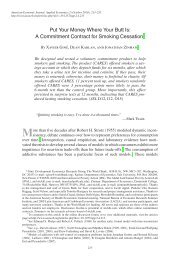Getting In Staying On Moving Up - GiveWell
Getting In Staying On Moving Up - GiveWell
Getting In Staying On Moving Up - GiveWell
Create successful ePaper yourself
Turn your PDF publications into a flip-book with our unique Google optimized e-Paper software.
GETTING IN, <strong>Staying</strong> on, <strong>Moving</strong> <strong>Up</strong> 23<br />
time. They alone decide when a phone call<br />
is sufficient follow-up to monitor a client’s<br />
progress and when a surprise early morning<br />
knock on the door is required. They decide<br />
when a program dropout is effectively<br />
beyond reach or when a few more phone<br />
calls might yet get the student back on track.<br />
<strong>On</strong> the other hand, in VFI’s performance<br />
records, the success of every <strong>Moving</strong> <strong>Up</strong><br />
participant is the responsibility of one case<br />
manager, one career advisor and one job<br />
developer. Each of these employees knows<br />
unambiguously which young people are “in<br />
my numbers,” and they must submit voluminous<br />
records every week on the progress<br />
of all their clients. (VFI management estimates<br />
that this record-keeping may take 30<br />
percent of a staff member’s time over the<br />
course of a year, and some staff members<br />
put the figure even higher.)<br />
Despite the discipline of individual<br />
accountability, the program is carefully<br />
structured and managed as a team effort,<br />
with different professionals jointly accountable<br />
for the same outcomes at various steps<br />
along the way. For example, exactly three<br />
months after a student is placed, that student<br />
shows up in the performance records<br />
of three employees—a case manager,<br />
career advisor and job developer—as either<br />
still employed or not employed. At that<br />
point, the tasks of the case manager and<br />
job developer are presumed completed,<br />
but the career advisor continues to be credited<br />
or debited, based on that client’s<br />
employment, at quarterly intervals over the<br />
two-year retention period.<br />
For the balance of the retention period,<br />
reports will show how many of the career<br />
advisor’s clients are employed at the 6th,<br />
12th, 18th and 24th months. The job developer<br />
may also be called on for further help<br />
in replacing a lost job or in helping a student<br />
advance; those assignments also<br />
become part of the job developer’s performance<br />
statistics. There are no gray areas in<br />
these numbers, and they count significantly<br />
in staff’s performance appraisals (although<br />
appraisals are naturally based on more than<br />
just data). Salary increases are likewise tied<br />
partly to performance measurements. With<br />
an especially high-performing staff member,<br />
for example, a pay hike may come<br />
more often than once a year.<br />
The kind of staff who succeed in this climate<br />
tend to be enterprising and versatile<br />
people—exactly what is needed for motivating,<br />
advising and brokering the career<br />
needs of young people who have few other<br />
successful adults to rely on. Just as important,<br />
they tend to be people who pass on<br />
their ambitious, “whatever-it-takes”<br />
approach to the young people they advise.<br />
Nonetheless, although VFI relies heavily on<br />
the ingenuity of staff and students, the<br />
organization has refined a set of practices<br />
and techniques that seem to tip the odds

















